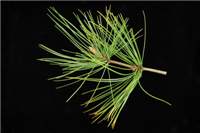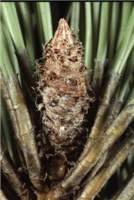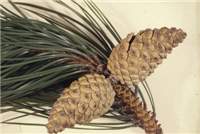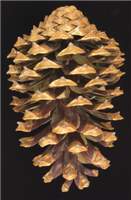Name
Pinus pinaster Aiton, Hortus Kew. (W. Aiton) 3: 367 (1789).[Maritime pine]
Description
Habit: A medium sized to large tree 40 m or more in height. Vary variable in form, but often with a curved or leaning trunk, heavy, upswept branches, and a sparse, open fairly flat-topped crown. Frequently in plantations older branches break off and the resultant untidy appearance of the trunks is a characteristic of the species.
Bark: In young trees pale grey and fissured, later dividing into small reddish or purplish brown plates which drop off leaving a reddish surface, giving the bark a characteristic appearance; becoming thickly and deeply fissured in older trees, especially near the base.
Foliage: Needles in pairs, usually 10-20 cm (occasionally 6-30 cm) long and typically very wide (1.5-2.5 mm but sometimes up to 3.5 mm or more), grey-green to deep green, stiff and curved, sometimes twisted, spreading in all directions from the end of the branchlet. Leaf sheath persistent, 2-2.5 cm long at first, whitish to greyish brown with long fine hairs or filaments, becoming shorter (5-10 mm) and grey or blackish in older leaves.
Branchlets: Greenish brown at first, becoming reddish or yellowish brown to grey-brown, without hairs, ridged. Remains of leaf bases prominent.
Winter buds: Cylindric-oblong, sometimes very large on terminal shoots; dark reddish brown; scales curled back, fringed with whitish silky hairs; non-resinous or with some resin.
Cones: Usually in dark clusters or whorls, sometimes solitary or in two’s or three’s, nearly stalkless or with short stalks; sometimes remaining closed on the tree for several years. Broad ovate to cylindric-conical, oblique at the base, 7-16 cm (occasionally up to 22 cm) long, 4-7 cm (occasionally up to 9 cm) wide when closed. Purplish when very young, becoming shiny brown when ripe, weathering to grey-brown. Scales oblong with a pronounced transverse ridge and with an upcurved prickle when young; sometimes enlarged and drawn out on the outer side of the cone.
Seeds: 7-8 mm long, oblong-ovoid, greyish to black, with a rough surface. Wing 20-35 mm long, varying in colour from pale fawn to almost black, but frequently light brown with dark grey-brown striations.
Notes
Mature trees can be distinguished from other pine species by their distinctive sparse, open, flat-topped crowns, thick reddish scaly bark, grey-green foliage and larger semi-persistent cones. Long stout needles in two’s (longer and stouter than any other two-needled pine); and very large winter buds with curled back, white, fringed scales are very distinctive features.
Natural Distribution
SW and S Europe, N Africa.



